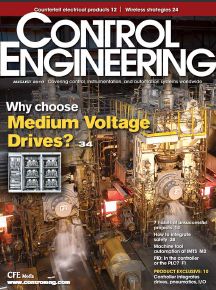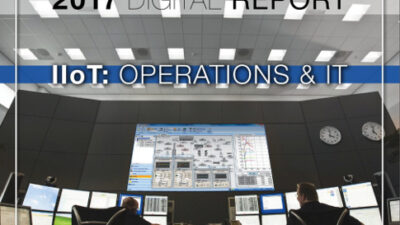Energy savings and other benefits of more common, low-voltage ac drives are becoming well known. Medium-voltage drives, operating from higher electric supply, bring ‘heavy lifting’ capability and further economies of scale to rugged applications. This is the August 2010 Control Engineering cover story.

Medium-voltage (MV) ac drives produce hundreds of times greater power output than their smaller, more numerous low-voltage (LV) cousins—enabling control of huge, multi-megawatt electric motors that power the largest of industrial loads found in mines, power stations, or metal processing plants. MV drives operate at higher supply voltages to obtain lower losses and use smaller cables that add up to better overall drive efficiency, hence lower system cost.
MV drives offer more than just size and not all models are of gigantic size. Other factors also influence their choice for specific applications and users—for example, control architectures that incorporate harmonics mitigation. The definition of “medium voltage” varies widely by industry. For motor drives, the range above 600 V to 15 kV represents some consensus; Europe regards 1 kV as the MV threshold. However, few actual drive products exist below 2.3 kV. Common MV drive inputs are 2.3 and 4.16 kV in the Americas, while Europe and the rest of the world prefer 3.3 and 6.6 kV. (See link at end of article.)
Power, voltage, current: P = VI
A major advantage of MV over LV drives is lower current flow for a given power output, as seen from the basic electrical engineering relationship: power equals voltage x current (P=VI). To illustrate, Tim Russell, senior system engineer at TM GE Automation Systems (TMEIC GE), compares two units rated at 1,000 hp (746 kW): the MV drive operating from 4,160 V supply carries only 125 amps or so, while the LV drive running on 460 V must carry 1,130 amps!
“MV cable construction is a bit more expensive, due to insulation requirements, but copper content is much lower due to lower amperage,” Russell says. This translates into much smaller cables and lower voltage drops. Overall cable cost favors MV technology. (TMEIC GE designs and develops advanced automation, large ac machines, and variable-frequency drives based on the combined heritage of Toshiba, Mitsubishi Electric, and General Electric.)
More costly power cabling needs of LV drives are well recognized at Rockwell Automation. Comparing 480 V and 4.16 kV drive systems at the same power load, Fred Jason—PowerFlex 7000 portfolio manager, Rockwell Automation Canada—arrives at the same approximate current requirements: LV drives draw about nine times the current compared to MV drives. It means larger and more LV cables per phase (see “drive-to-motor cabling” table), larger and heavier cable tray or conduit, and more costly cable installation, according to Jason.
At ABB Inc., use of smaller gauge cable for the same output is likewise seen as an advantage for MV drives. “It’s first seen in reduced copper cost, but also in less labor cost to pull the cable, as well as in the number and size of conduit pipes,” says Paul Nolden, program manager, MV drives. “This becomes increasingly important in applications with long input and motor cable lengths, as in remote lift stations, deep wells, and mining.”
Siemens Industry Inc. also notes the lower cost of physically smaller MV cabling and switchgear. “Still, this is a ‘hard sell’ to customers who seem to attach little credit to the cable benefit,” says Scott Conner, manager, large drives sales applications engineering. “Sometimes customers don’t want to pull the bigger LV cables, but it’s more an installation complexity issue for them rather than just cost savings.”
Better economy above 500 hp
Although MV drives provide the only practical choice at some power demand level, a wide output range exists over which they can be a “better economic solution.” TMEIC GE puts this range between 500 to 1,500 hp, depending on the application and industry (see “relative cost” diagram).
Other reasons to select MV drives given by TMEIC GE include applications where:
- Synch-to-line is required and the utility feeder is medium voltage;
-
Utility capacity at low voltage is inadequate for the drive load (for example, due to large inrush currents for motor starting that MV drives avoid); and
-
Long cable runs (>300 ft/92 m) exist from drive to motor—and cable size, cost, and voltage drop become substantial.
Siemens notes an overlap for medium- and low-voltage drives in the 300 to 2,000 hp range. In Europe, LV drives tend to range higher due to use of voltages like 690 V. Based on Siemens’ end users’ experience, selecting MV drives becomes an “easier decision” around 1,000 hp, where they start to be size competitive and use of an MV motor often becomes a necessity, Conner explains.
“LV drives become cumbersome to implement at high power outputs, including the need to parallel power semiconductors. At some output point, MV switching devices provide operational and packaging advantage but not necessarily cost. However, for MV drives overall, cost per horsepower has come down in recent years,” adds Conner.
Rockwell Automation’s Jason thinks an MV drive can be “extremely cost competitive” with an LV drive at higher power levels. To make the decision, a total installed cost analysis is necessary. “It’s important to evaluate operating costs over the project life cycle, including system efficiencies, input power factor, cable costs, air conditioning needs, and maintenance requirements,” says Jason. Cost of additional system components required for an LV system, such as input and/or output transformers, must be factored in.
ABB also recommends that choice of MV or LV drive be based on total installation cost. Converter to converter, LV may have lower cost to power ratio (up to some point), but other required system add-ons can quickly overcome that advantage, explains Nolden. For example, a step-down transformer is always required for an LV drive, but not so for an MV drive (see transformerless design). Moreover, any harmonic filtering added to an LV drive leads to lower system efficiency and higher cost, he notes.
“Besides efficiency, cost of material and installation labor is less for medium-voltage drives, mainly due to the smaller cable conductor size,” says Rick Hoadley—principal consulting applications engineer, MV drives—at ABB. Moreover, amperage rating of available semiconductors and high current density seen throughout the drive makes designing LV drives in the 1,000–3,000 hp range increasingly difficult, according to Hoadley. “There is a point where packaging of multiple power devices in parallel becomes too large and too costly,” he adds.
Handling harmonics
Variable-frequency drives (VFDs), either low- or medium-voltage type, are prone to generate unwanted voltage/current harmonics. Because MV-VFDs operate closer to distribution voltages and represent large power sources, they’re more often compelled to include harmonics reduction in their designs. Hoadley suggests that perhaps 20% of LV drives specifically incorporate harmonic mitigation, while almost all MV drives employ it. Low harmonic distortion then becomes a further attraction.
Traditional MV drive design depends on a multi-pulse transformer to limit harmonics. Hoadley notes that the input transformer works together with the drive’s multi-pulse rectifier section (18, 24, 36, or even higher pulses), which produces cancelling waveform patterns to minimize line-current harmonics.
“Harmonic cancellation” is typically part of the basic design, according to TMEIC GE’s Russell. It comes from common use of multi-winding, phase-shifted transformers that shape output waveforms and provide input isolation. “Harmonic cancellation then results from the configuration of the rectifier circuits and windings,” Russell says. Moreover, for high-performance applications with dynamic loads, MV drives include an active front end to provide harmonic control.
While either of these techniques could be applied to low-voltage drives, they don’t require transformers for output wave configuration, and the additional cost is usually not warranted, he explains. Yet LV drives typically require additional harmonic filtering. “Adding harmonic cancelling filters and/or transformers to LV drives often has them approaching the cost of comparable MV drives,” Russell states.
‘Transformerless’ design
Transformers represent a major investment in large, heavy equipment. The premise of eliminating the input transformer in medium-voltage drives is clear: it enables dramatic cuts in unit size and weight, as well as cost reduction. “Transformerless” MV drive operation is not new, but real product practicality has come only with modern designs. These MV drives rely on an active front end (AFE) rectifier plus power electronics advances to obtain beneficial functions normally provided by the isolation transformer.
Rockwell Automation, a strong advocate of transformerless MV drives, enthusiastically promotes that option in its PowerFlex 7000 product line—along with the traditional design. Navid Zargari, manager of R&D at Rockwell Automation Canada, cites weight and volume reductions of 67% and 59%, respectively, for transformerless versus traditional MV drives in otherwise comparable 950-kW systems.
Rockwell’s transformerless design, trademarked “Direct-to-Drive” technology, combines an AFE rectifier—to minimize line-side harmonics via its switching pattern—and a special dc link inductor, which virtually eliminates common-mode voltage stresses harmful to motor winding insulation, explains Zargari, who had a major role in the company’s Direct-to-Drive development.
Power-switching devices, in this case, symmetrical gate-commutated thyristors (SGCTs), also help to limit harmonics and reduce filtering requirements for voltage transients. “Output current and voltage waveforms are near sinusoidal, resulting in virtually no voltage stress on the motor winding, even if connected through long cables,” Zargari adds.
Transformerless MV drives are especially attractive to limited space applications. Of course, suitable supply (or utility) voltage must be available for implementation; otherwise a step-down transformer is still needed at the drive input. Actually, this kind of “correct MV bus” may already exist in some industrial facilities (see related article).
Other manufacturers have not neglected the transformerless drive approach. ABB offers such an option (which it calls “direct-to-line”) in its ACS 2000 and ACS 6000 MV drives; and TMEIC GE’s TM-30 and TM-50/70 drives with active source converter can operate without a transformer given the “proper utility voltage.” Find further perspective on transformerless MV drives in a related article.
As their cost to power ratio continues to improve over time, medium-voltage ac drives—of either traditional or transformerless design—can expect wider application by informed users with energy efficiency in mind.
Frank J. Bartos, P.E., is Control Engineering consulting editor. Reach him at [email protected].
For more information, visit:
www.abb.us/drives
ONLINE extras
- What’s medium voltage? It depends on application, industry
- Transformerless medium voltage drives perspective
- Inverter topologies: Voltage-source or current-source
Other MV drives information worth reading
The following sources represent worthwhile reading and are recommended for more in-depth knowledge about medium-voltage ac drive technology:
1) Bill Horvath, PE, “Medium Voltage Drives Overview, Evolution & Application,” TM GE Automation Systems (Nov. 2004)
2) Rolf-Dieter Klug and Norbert Klaassen, “High Power Medium Voltage Drives—Innovations, Portfolio, Trends,” Siemens AG, Large Drives Division (2005)
3) Joable Andrade Alves, Gilberto da Cunha and Paulo Torri, “Medium Voltage Industrial Variable Speed Drives,” WEG Automation, Brazil (2009)


